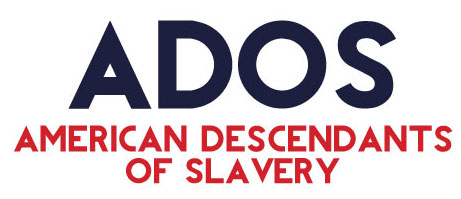*In recent weeks as Democratic candidates have announced their bid for the Presidential nomination of the party, the national discussion is shifting from the U.S.-Mexico border and DACA to a reckoning with America’s original sin: chattel slavery.
From Kamala Harris to Elizabeth Warren, candidates have announced they are for reparations and then shown a clear lack of understanding of what that commitment means in their respective solutions. What Senator Harris is proposing in her LIFT act, is a class-oriented response to an injustice that is grounded in race.
Senator Warren is suggesting she would include Native Americans in a reparations package, and Senator Bernie Sanders has put forth a stance that is tantamount to being against reparations altogether. A major driver for this discussion has been the online movement #ADOS, or American Descendants Of Slavery, which was founded by myself and Yvette Carnell.
Our movement aims to make U.S. descendants of slavery whole by foregrounding the necessity of recompense for the wide-ranging damages done to black America throughout our nation’s history. A justice claim beginning with slavery, and encompassing the legacy of disadvantage which reaches right up to the present.

If America truly hopes to heal from the tragedy of slavery and the systemic racism that followed, the country will need to pay a multi-trillion dollar debt to American descendants of slavery in the form of both cash payments and large scale programs. When assessing the concept of reparations, the key factors we need to look at are: 1) how much would it cost, 2) who should receive it, and 3) how do we implement it.
How much would it cost?
While the sum owed in reparations for the entirety of anti-black discrimination in the United States is undetermined, the amount of the claim just evaluating slavery in isolation—without the era of Jim Crow that followed—is in the trillions. The market price of the average slave was roughly equal to the price of a house; using relative earnings, a single slave worth $400 in 1850 would today be worth $195,000. As Professor Sandy Darity Jr.—a leading economist and premiere scholar in the area of American reparations— and Prof. Dania Frank have illustrated using the work of Vedder, Gallaway and Klingaman, the gains in wealth to white southerners from ownership of blacks in 1859 was $3.2 million. In today’s dollars, the value of that debt is estimated to be somewhere between $5 to $10 trillion dollars, depending upon the interest rate used for compounding purposes. Economist Larry Neal of the University of Illinois calculated an even more specific number looking just at wages. His research indicated that between the years of 1620-1840, minus the cost of maintenance (medical, food, housing) descendants of slaves in America were owed $1.4 trillion. Using an interest rate of 5%, that’s a total of $8.4 trillion in today’s money just in lost wages.
All too often we forget what slavery was as an institution. Slavery, it must be understood, served as the foundational pillar of American free market capitalism and was essential in shaping our core beliefs and attitudes about that economic system. It was one man using governmental legal advantage—expressed through race—to not only lock another man out of free trade, but also force him to be the very commodity which was to be traded under the most horrific conditions imaginable. Moreover, despite what has been taught, slavery was not just an institution particular to the regional South; rather, it was an American institution. All of the transatlantic shipping ports for cotton were located in the North, much of the manufacturing for slave clothes was in the North, and, most importantly, the banks that undergirded a system that made man into currency were in the North. Even if a person did not own slaves, white America as a whole greatly benefited from the nation’s economic growth as a result of slavery as an institution.
In addition, the period of Jim Crow that followed made black Americans into a literal contagion to wealth. Whether by employment racism, redlining, or outright theft of land the little black wealth that did exist was constantly pillaged. To give context through redlining a process where neighborhoods were graded for home loans, — with those communities with any black families receiving the lowest grade — the government through the Federal Housing Administration made it so a single black family’s presence literally destroyed home ownership wealth not only for that family, but the whole neighborhood that surrounded. Forcing black life to be closed off from gaining wealth during America’s most prosperous periods. This left blacks shut out of an America their forefathers built well after the last of the slaves were freed. All while after the New Deal white home ownership rates rose from below 50%, to now being above 70%, occupying most of the prime real estate across the country. In contrast black home ownership rates are currently at their lowest levels in 50 years, and have seen little to no growth since the Civil Rights era. This is mirrored in ownership of rural land, according to the USDA black America, despite building the nation as slaves, own less than 1 percent of rural land in the country. The combined value of this land being a mere $14 billion. White Americans, by comparison, own more than 98 percent of U.S. agricultural land amounting to 856 million acres, with a total worth of over $1 trillion. Of all private U.S. agricultural land, Whites account for 96 percent of the owners, 97 percent of the value, and 98 percent of the acres. These are the financial echoes of slavery and Jim Crow reverberating in our society today.
With this in mind, the U.S. owes a massive debt to the progeny of American slavery. What we find is that the consequences of the creation of race and the dissemination of advantage and wealth based on color and lineage has had lasting impacts on those families that were continuously left out of America, all while their descendants bodies and labor built the very foundation this nation sits upon.
Who should receive it?
While wealth transferred through reparations can never make right those wrongs done to African Americans through chattel slavery and the periods of anti-black discrimination that followed, we as a society are obligated to make those families whole who were so wronged at the hands of such an immoral institution. Recently we have seen the United States paying out reparations from France to Holocaust victims. And while the millions paid to those victims is substantially lower than the trillions needed to make black Americans whole, the method used in determining who was a victim proves useful in terms of guidance. Stuart Eizenstat, the State Department’s special adviser for Holocaust issues, stated “We made the argument [to the French government] that they were standing in the shoes of people who would have been eligible” in justifying heirs to be eligible to receive reparations. In the case of the debt owed for slavery in the United States, this line of logic is just as applicable, if not more so. For generations the cost of slavery and blackness has been passed down through the creation of a caste system whereby African Americans are chained to the bottom of society because of their dire economic condition, and the cyclical cost of race.
By every legitimate metric this is a multi-trillion-dollar debt. However, that sum will not be paid out to black Americans at large, but would instead go specifically to the progeny of victims of American chattel slavery and the oppressions that followed, such as Jim Crow. Using the standards set out in the paper by Prof. Darity and Prof. Frank, “The Economics of Reparations,” the criteria for eligibility would be:
- An individual would have to provide reasonable documentation of at least one ancestor enslaved in the United States, and
- They would need to demonstrate they have identified as black, African American, Colored, or Negro on established legal documents for at least 10 years prior to the onset of the program
Effectively this would limit reparations solely to those people who have lineage that ties them both to slavery in the United States, and the subsequent era of Jim Crow. Any black immigrant who came to the United States voluntarily after slavery would not be eligible to receive reparations. This distinction is critical since a sizeable number of black immigrants in fact arrived in the U.S. following black America’s most historically significant and economically detrimental periods that occurred prior to the Civil Rights movement. In fact few if any voluntary black immigrants outside of students were in the United States prior to the Immigration and Nationality Act of 1965. As shown by the Smithsonian, “Before 1965, black people of foreign birth residing in the United States were nearly invisible. According to the 1960 census, their percentage of the population was to the right of the decimal point.” Importantly, this pre-1965 group of black immigrants mostly originated from the Caribbean, and—as such—would have their own particular claims to make against European nations for the harms they suffered based on the slavery instituted within their Caribbean country of origin. Reparations for American chattel slavery would exclude black immigrant populations that voluntarily migrated to America, which—since 1980—have undergone an unprecedentedly sharp expansion, increasing from 816,000 in 1980 to 4.2 million as of 2016. After deducting for these foreign-born blacks and their offspring conceived by two parents who didn’t descend from American chattel slavery, the recipient group shrinks substantially.
How do we implement It?
Reparations can be paid for by the US government through taxation or borrowing. Using modern monetary theory, you could first fund reparations, and the subsequent tax revenue generated by spending would pay for the cost. America could also fund reparations and proceed to hold jointly liable all involved African nations that traded slaves to America’s shores in mass, and Great Britain whom was in control of America from 1619 -1776, and was among the main beneficiaries of the cotton produced after America’s independence.
Reparations should come in the form of a large cash payment to African Americans, as well as large-scale initiatives targeted at this specific group: American Descendants Of Slavery. These policy items could include—but should not be limited to—debt free college, home ownership assistance, business financing support, fully endowing all historically black colleges (and incentivizing those schools to admit descendants of American slavery), guaranteed government contracts for black businesses, and free medical care.

Regardless of how it’s paid for this is the longstanding American debt whose recompense will cleanse our nation’s soul. Initiating a reparations plan can lead to a moment of restorative justice as envisioned by Dr. Martin Luther King Jr. when he sought economic inclusion of black America so long ago. In making the first step, what’s required above all is the resolve to frame the discussion around bold, large-scale proposals for achieving reparative justice. These are the imaginative times we have waited on for generations. Reparations and the call to make it a reality are finally upon us. It is our job to answer that call and begin to help America repent for its original sin of slavery.

Antonio Moore is an attorney based in Los Angeles and one of the producers of the Emmy-nominated documentary Freeway: Crack in the System. Moore is a co-founder of #ADOS American Descendants of Slavery. He has contributed pieces to Huffington Post, The Grio, and Inequality.org on the topics of race, mass incarceration, and economics. Follow him on Twitter and YouTube. Full ADOS American Descendants of Slavery Agenda www.ados101.com
We Publish News 24/7. Don’t Miss A Story. Click HERE to SUBSCRIBE to Our Newsletter Now!





